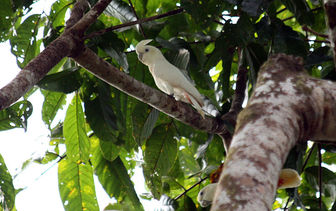Red-vented Cockatoo
The plumage is all white with red undertail coverts tipped white, yellowish undertail and pale yellow underwings. It is 12.2 inches long and has an 8.6 inches wingspan.

Original source: Picasa Web Albums
Author: jacobusmulder
The Red-vented Cockatoo is classified as Critically Endangered (CR), facing an extremely high risk of extinction in the wild.
The Red-vented Cockatoo is a critically endangered species endemic to the Philippines. The upper body of a mainly white cockatoo that has raised its left leg to its black beak. Pale-yellow crest feathers are just seen under the more prominent white crest feathers. It has a wide circular rim of featherless blue skin around its eyes. Its irises are brown. The Blue-eyed Cockatoo is a vulnerable species endemic to New Britain. More
Red-vented Cockatoos were formerly widely distributed on all larger and many smaller islands of the Philippines, excluding northern and central Luzon. In the early 1990s the total wild population was estimated at 1000-4000, however, by 2008 this was reduced to probably less than 1000. Now remnant populations exist on the islands of Palawan, Tawitawi, Mindanao and Masbate. The species stronghold is the Palawan Faunal Region where the Katala Foundation has been running the Philippine Cockatoo Conservation Programme since 1998. More
Red-vented cockatoos can live up to 40 years. Precise data on life span of the average red-vented cockatoo is poorly documented. Many succumb to disease or injury rather than living for their potential life span. Red-vented cockatoos can be difficult to breed in captivity. Wild caught pairs may take years to adapt and become reliable breeders. More
Red-vented cockatoos are inquisitive and love to chew objects in their surroundings but are not as destructive as other cockatoos. They should always be provided with toys, blocks of wood or branches that they can chew. They need to have some space for flight. Feeding Cockatoos should be fed a formulated (pelleted or extruded) diet as a basis for good nutrition. The diet should be supplemented with fresh fruits and vegetables daily to add variety and psychological enrichment. More
My obsession with red-vented cockatoos began on a cold, snowy Sunday in March of 1993. I sent my husband, Bob, and our good friend, Marv, to the local pet shop for supplies. More
the male red-vented cockatoo that she enjoyed, but never mated with. - Due to rarity, Ariel should be put into a breeding program. I will sell her as a pet to the right home as I feel that this may make her happier. More
tags: Red-Vented Cockatoo, Cacatua haematuropygia, birds, Image of the Day Second in a series of psittacine images by this photographer. The Critically Endangered Red-Vented Cockatoo, Cacatua haematuropygia. Image: John Del Rio. . Find more posts in: Life Science Share this: Facebook Twitter Stumbleupon Reddit Email + More TrackBacks TrackBack URL for this entry: http://scienceblogs.com/mt/pings/69392 Comments 1 Unbearable cuteness. More
The Red-Vented Cockatoo, (Cacatua haematuropygia) One of the most threatened cockatoo species (C.I.T.E.S. Appendix One) by Cliff Wright More
Red-vented Cockatoo Threats There are two main reasons for the radical decline in the number of Philippine Cockatoos More
Although the Red-vented Cockatoo is quieter than most cockatoos, and much quieter than the Umbrella Cockatoo or Moluccan Cockatoo. Training and behavioral guidance will help your pet be the kind of companion you want it to be ... * AvianWeb Resources: I put together web resources for you to help you understand your pet bird and properly direct him. More
While the Red-vented Cockatoo are not as loud as some of the larger Cockatoos, they are still not apartment pets. Pricing: Red-vented Cockatoos are extremely rare, and are classified as highly endangered. The breeding success rate of this species has been very low. For this reason, they are expensive parrots. Feel free to call our store at (954) 725-0088 for pricing and availability if you are interested in purchasing one. More
The Red-vented Cockatoo is endemic to the Philippines where small populations exist on the islands of Palawan, Tawitawi, Mindanao and Masbate. It is restricted to lowland primary forest and secondary forest in or adjacent to waterways with mangroves. They are partially nomadic due to seasonally fluctuating food sources. Will even frequent nearby corn and rice fields. REPRODUCTION Red-vented Cockatoos will pair during mating season. Often multiple pairs will use the same tree for breeding. More
Red-vented cockatoos (Cacatua haematuropygia) have become extremely rare and are considered the most endangered bird in the Phillippines other than the Phillippine eagle. The range is now limited to a few of the smaller islands including Palawan, which is their last stronghold. It is heavily dependent upon coastal mangrove but also found in lowland forests. They feed on seeds, nuts, fruits and berries. Appearance and Personality Red-vented cockatoos are small white cockatoos with a short white recumbent crest. More

Original source: Patrick Gijsbers
Author: Patrick Gijsbers
Permission: Some rights reserved
Family : Psittacidae
Genus : Cacatua
Species : haematuropygia
Authority : (Müller, 1776)

